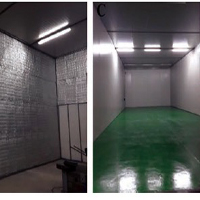Environmental indoor thermal control of extra virgin olive oil storage room with phase change materials

Published: 27 November 2019
Abstract Views: 1221
PDF: 735
HTML: 236
HTML: 236
Publisher's note
All claims expressed in this article are solely those of the authors and do not necessarily represent those of their affiliated organizations, or those of the publisher, the editors and the reviewers. Any product that may be evaluated in this article or claim that may be made by its manufacturer is not guaranteed or endorsed by the publisher.
All claims expressed in this article are solely those of the authors and do not necessarily represent those of their affiliated organizations, or those of the publisher, the editors and the reviewers. Any product that may be evaluated in this article or claim that may be made by its manufacturer is not guaranteed or endorsed by the publisher.
Similar Articles
- Costanza Di Stefano, Gian Vito Di Piazza, Vito Ferro, FIELD TESTING OF THE SMBF FLUME , Journal of Agricultural Engineering: Vol. 38 No. 4 (2007)
- Rim Khamaletdinov, Vladimir Martynov, Salavat Mudarisov, Ildar Gabitov, Eduard Khasanov, Anton Pervushin, Substantiation of rational parameters of the root crops separator with a rotating inner separation surface , Journal of Agricultural Engineering: Vol. 51 No. 1 (2020)
- Marco Benetti, Franco Gasparini, Andrea Peruzzi, Luigi Sartori, Evaluation of the effects of different openers mounted on no-tillage planters on maize: a field study , Journal of Agricultural Engineering: Vol. 55 No. 3 (2024)
- Costanza Di Stefano, Vito Ferro, Stefano Mirabile, TESTING THE GRAIN-SIZE DISTRIBUTION DETERMINED BY LASER DIFFRACTOMETRY FOR SICILIAN SOILS , Journal of Agricultural Engineering: Vol. 42 No. 3 (2011)
- Giuseppe Ciraolo, Mario Minacapilli, Maurizio Sciortino, STIMA DELL’EVAPOTRASPIRAZIONE EFFETTIVA MEDIANTE TELERILEVAMENTO AEREO IPERSPETTRALE , Journal of Agricultural Engineering: Vol. 38 No. 2 (2007)
- Marco Fiala, Giuseppe Pellizzi Prize 2018 , Journal of Agricultural Engineering: Vol. 49 No. 1 (2018)
- Pasquale Dal Sasso, Maria Antonella Ottolino, GREENWAY IN ITALY: EXAMPLES OF PROJECTS AND IMPLEMENTATION , Journal of Agricultural Engineering: Vol. 42 No. 1 (2011)
- Giuseppe Taglioli, Angelo Fabbri, PROVE IDRAULICHE SU UN SEMOVENTE IRRIGUO , Journal of Agricultural Engineering: Vol. 38 No. 3 (2007)
- Robinson Osorio Hernandez, Jairo Alexander Osorio Saraz, Keller Sullivan Oliveira, Ivan Dario Aristizabal, Julio Cesar Arango, Computational fluid dynamics assessment of effect of different openings configurations on the thermal environment of a facility for coffee wet processing , Journal of Agricultural Engineering: Vol. 51 No. 1 (2020)
- Alina Evelyn Badillo-Márquez, Jonathan J. Cid-Galiot, Rubén Posada-Gómez, Alberto Alfonso Aguilar-Lasserre, Automated system for the detection of risk in agricultural sugarcane harvesting using digital image processing and deep learning , Journal of Agricultural Engineering: Vol. 55 No. 3 (2024)
<< < 53 54 55 56 57 58 59 > >>
You may also start an advanced similarity search for this article.

 https://doi.org/10.4081/jae.2019.947
https://doi.org/10.4081/jae.2019.947






